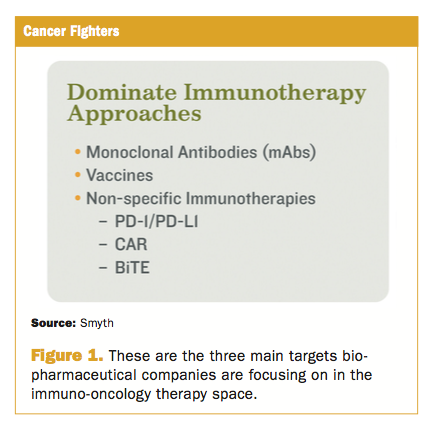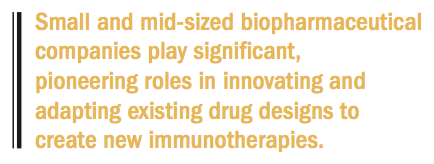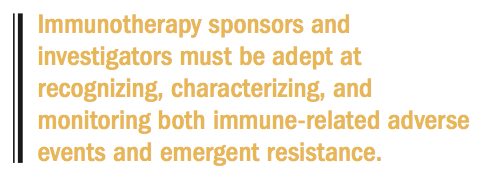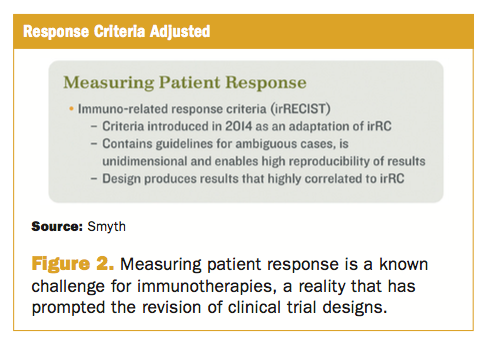Imagining the Impossible: Immunity to Cancer
Applied Clinical Trials
The smaller biopharmaceutical company perspective on mastering oncology immunotherapy clinical trials.

During the past few years, several novel cancer treatments have emerged that are designed to leverage a patient’s own immune system to disrupt, halt, or reverse cancers. This category, known as immunotherapy or immuno-oncology, features mechanisms of action as varied as the candidates themselves. Early data with this class of drugs, particularly with checkpoint inhibitors such as ipilimumab, nivolumab, and pembrolizumab, as well as “personalized” immunotherapies such as chimeric antigen receptor T cells (CAR-T) and dendritic cell vaccines, has been so compelling that standards of care in a range of tumors are rapidly shifting, and drug developers are clamoring for ways to leverage these technologies.
In light of such innovative treatments, many traditional clinical trial parameters common to chemotherapy or even the more recent targeted antibodies or kinase inhibitors must be revisited for their application to examine the safety and effectiveness of immunotherapies. This challenge, and others presented by immunotherapy trials, require expertise and experience to master, and can be especially challenging within biopharmaceutical companies with smaller staff. This article explores five challenges smaller biopharmaceutical companies should prepare for when embarking on immunotherapy studies.
Three approaches dominate
Monoclonal antibodies
Monoclonal antibodies (mAbs) are one of the three most significant immunotherapy approaches, along with vaccines and non-specific immunotherapies, that pharmaceutical and biotech companies are pursuing to thwart cancer’s hallmark ability to evade the immune system. Targeted mAbs for cancer by themselves are not new-the first FDA approval being rituximab for the treatment of lymphoma, followed closely by trastuzumab for breast cancer nearly 20 years ago. What has emerged recently, however, is an ability

to leverage mAbs to reengage the immune system to identify and attack one’s own cancer cells. This category, generally characterized as checkpoint inhibitors, has garnered much interest because such products are designed to, in combination with traditional agents or other immunotherapies, prompt immune attacks that target only cancer cells and spare healthy tissues. They can help the immune system act as it was designed to do, with quite durable effects that can last years.
immunotherapies, particularly more recent immuno-oncology products, are not yet as common as first-line therapies, but pharmaceutical and biotech companies are aggressively pursuing such indications as they examine candidates in a variety of combinations and against various tumor types. The estimated cancer immunotherapy market value, totalling about $41 billion in 2014, is almost half of the overall oncology drug market.1
Vaccines
Immunotherapy cancer vaccines are designed to fight, not prevent, existing cancer. Together with preventive cancer vaccines, such as Gardasil and Cervarix, which are designed to thwart human papilloma virus infections that can lead to cervical cancer, cancer vaccines sales comprised a market valued at about $4.0 billion in 2014, with modest growth rates anticipated to reach about $4.3 billion in 2019.2,3 One tally estimates more than 280 candidates in cancer vaccine pipelines globally.4
However, to date, the only immunotherapy cancer vaccine approved by the U.S. Food and Drug Administration (FDA) is Provenge (sipuleucel-T), made by Dendreon Corporation, now Valeant Pharmaceuticals. The vaccine was cleared for marketing in April 2010. A second vaccine was cleared in October 2015-Amgen’s T-VEC (talimogene laherparepvec)-which is a dual-acting cancer vaccine/viral therapy for melanoma patients.5
Non-specific immunotherapies
Non-specific immunotherapies target cancer cells indirectly by prompting immune system attacks. Among this group of treatments are laboratory-made cytokines, interleukins, interferons, and GM-CSF, as well as mAbs designed to alter the function of T-cell checkpoints.6
PD-1/PD-L1. Cancer cells are adept at manipulating and controlling T cells to ignore tumor cells. Recent drugs are designed to target a T-cell checkpoint protein’s function to help counter that control. Such drugs interfere with either the programmed death 1 (PD-1) receptor or its binding protein, PD-L1. PD-1, when activated by PD-L1, puts the brakes on T cells, which while useful for regulating autoimmunity, also allows cancer to proliferate. Cancer cells can express PD-L1, thus permitting them undue influence over T cells. Such cancers are often aggressive and, in the past, patients had a poor prognosis.
Checkpoint inhibitors are helping to change this prognosis via two different mechanisms of action. They can protect PD-1 from cancer cell manipulation or they can bind up the cancer cells’ PD-L1 to limit its interaction with T cells. The mAb pembrolizumab was, in September 2014, the first PD-1-blocking drug to receive FDA approval, with the second, Opdivo (nivolumab), made by Bristol-Myers Squibb, receiving approval in December 2014, both indicated for certain melanomas. In March 2015, the FDA expanded Opdivo’s indication to certain lung cancers, and in July it was approved in Europe for non-small cell lung cancer. Morningstar projects these two drugs will be worth $33 billion by 2022 because both are being tested for other cancer types.7
CAR immunotherapy uses a patient’s own T cells to fight cancer. Through genetic engineering, the T cells are modified and induced in the laboratory to produce CARs corresponding to an antigen of a patient’s specific cancer cells, such as the CD19 protein on the surface of cancerous B cells. After billions of copies are made and reintroduced to the patient, the T cells recognize the cancer cells bearing the antigen and induce a lethal immune response. Oncologists have hailed CARs as very promising for both solid tumor and hematologic malignancies; in fact, CARs eventually may “become a standard therapy for some B-cell malignancies.”8
BiTE antibodies are two separate laboratory-made antibodies that are bound together. One antibody binds to a patient’s T cells, while the other links to certain markers largely expressed on the cancer cell, such as CD19. When bridged together, the T cells can launch attacks that induce cancer cell death. Amgen’s investigational BiTE antibody blinatumomab received FDA breakthrough therapy designation in July 2014 and was approved in December 2014 for a specific type of acute lymphoblastic leukemia. The company also announced an agreement in January 2015 with The University of Texas MD Anderson Cancer Center to explore the use of BiTE technology for myelodysplastic syndrome (MDS).9
Special challenges for smaller biotechs pursuing immunotherapy clinical programs
Small and mid-sized biopharmaceutical companies play significant, pioneering roles in innovating and adapting existing drug designs to create new immunotherapies. Because such sponsors typically have limited staff, they often require outsourcing support to plan, launch, and manage clinical investigations. When seeking support, sponsors should assess their CROs and vendors for expertise and experience specific to immuno-oncology, because these types of trials, more than traditional chemotherapy studies, bring with them several obstacles, such as those characterized by the Society for Immunotherapy of Cancer (SITC).10
Obtaining protocol approvals
Smaller-sized sponsors may find themselves for the first time negotiating the trial protocol, conduct, and endpoints, as well as the regulatory pathway, either alone or with a larger partner. A CRO can provide experience-based counsel and tactical support to write or review a trial protocol that ensures successful recruitment and data collection, as well as the required evaluations. Because immunotherapy endpoints are not traditional, and oncology practitioners are

still gaining experience with this class of drugs, a well-written protocol can guide the investigators and trial staff as they adapt to this new class of treatments. The protocol design is particularly important because of the emerging popularity of testing combinations of drugs within the same protocol.
As part of protocol drafting, or even a near-final review before finalization, sponsors should understand the “sticking points” in the regulatory processes as well as the institutional review boards and independent ethics committees (IRB/IEC) processes, enabling sponsors to address them proactively in their trial design and submission material. As with oncology practitioners, while site-level regulatory bodies have reviewed and approved immunotherapies, many IRB/IECs may be unfamiliar with immunotherapy clinical trial designs, methods of action, evaluations, or side-effect profiles.
Country-level approval processes for sponsors of international trials must address the varying requirements regarding the production and use of biologics by different national or regional regulatory bodies. For example, good manufacturing practice (GMP) regulations are required for trials in the European Union, but FDA recognizes that commercial production and warehousing, which are subject to GMP regulations, may not be appropriate for the manufacture of Phase I investigational drugs. Therefore, the FDA requests sponsors submit product chemistry, manufacturing, and control information as part of an investigational new drug application (IND) for a determination of sufficient safety.
Enrolling and retaining the right patients
Another challenge for sponsors is identifying, recruiting, and retaining specific patient populations as defined by their immune status and genetic makeup of their cancers, both of which are entwined with the development of enrollment and endpoint criteria and may require companion diagnostic tests. Addressing this challenge involves many evolving strategies, including the use of biomarkers and genetic sequencing data. Smaller companies may need assistance from a CRO’s scientific and data team to plan robustly for how they and trial sites might address such issues for the duration of a trial.
The International Cancer Genome Consortium (ICGC), coordinated by the Ontario Institute for Cancer Research in Toronto, Canada, publishes information to help guide treatment development and patient selection. The ICGC aims to catalogue every genetic mutation in 50 different cancer types by analyzing a minimum of 500 individual samples of each type. ICGC participants hail from Australia, Canada, France, India, China, Japan, Singapore, the U.K., and the U.S.
Another resource is a SITC catalogue of “references and online resources relevant to the discovery, evaluation, and clinical application of immune biomarkers” so that they might be applied to the “development, clinical evaluation and monitoring of cancer immunotherapies.”11
Moreover, the Cancer Immunotherapy Trials Network (CITN) is addressing diagnostics and bioinformatics as part of its mission to make immunotherapies broadly available to patients with cancer. CITN, funded by the National Cancer Institute (NCI) and Fred Hutchinson, designs and conducts early phase trials to provide “high-quality immunogenicity and biomarker data that elucidate mechanisms of response or failure and thereby facilitate the design of subsequent trials ... [and uses] only GMP agents with validated reproducible and reliable manufacturing at scale by a company, the NExT (NCI Experimental Therapeutics) program, the former RAID (Rapid Access to Interventional Development) program, or an equivalent experienced organization.”12 CITN member sites include NCI and 29 academic medical centers, and works in collaboration with foundation and industry partners.
Planning for logistics, product production, and assessment
Preclinical immunotherapies can be made in the laboratory on a small scale. In contrast, immunotherapy clinical trials require larger scale product production but with the same purity and specificity. Unlike small molecules, however, targeted vaccines are not typically made in homogenous batches. Rather, they require harvesting immune cells and tumor samples from individual patients and different trial sites at different times, transport of these samples to qualified facilities for manipulation and proliferation, and then shipping back to the investigator for patient infusions. Temperature control, customs clearance facilitation and regulation compliance are just part of what sponsors need to consider and require for their secure chains of custody during immunotherapy trials.
Sponsors may need counsel on manufacturing sources for their candidate immunotherapies if they do not own facilities or have access to one via a large pharmaceutical partner. A CRO can advise sponsors on the availability and capability of academic or contract-based manufacturing facilities that can reliably provide the quality and quantity of product needed to support the trial’s sites. CROs also can advise on a trial’s assessments, such as the best methods and facility for centralization of immunological monitoring or how to use training and protocols to reduce data variability if different laboratories must be used to accommodate trial sites.
Dosing and measuring response
Determining the ideal dosing protocol for the best patient response can be novel territory for immunotherapy developers. Large pharma companies can obtain experience through multiple advisors, trials, and resources that permit revisiting the drawing board to make such determinations. In contrast, smaller sponsors usually have the budget for one trial.
Early phase trials in oncology traditionally aim to establish the maximum tolerated dose (MTD) for later phase trials. The challenge for sponsors here is that immunotherapies can exhibit therapeutic responses at dose levels below where toxicity is seen, and thus one may not necessarily want to identify the highest possible dose that a patient can tolerate. In addition, immunotherapies are now typically being investigated as part of a combination treatment with other marketed or investigational agents. Even if the safety profile of each agent as a monotherapy is well characterized, the effects in combination are unknown and can be substantially different than anticipated. SITC noted that such combinations are problematic for using classical methods to determine MTD and recommended that an optimal biologically active dose (BAD) might best consider both a toxicity grade and an immune response score.14
Measuring patient response is a known challenge for immunotherapies that has prompted the revision of clinical trial designs. No “universal” criteria to measure immunotherapy response have been adopted for research or clinical care, and the FDA still holds survival as a gold standard for cancer treatment. That said, both pembrolizumab and nivolumab were initially approved based on small, single-arm

trials that utilized surrogate endpoints such as overall response rate and duration of response.
Looking back, traditional chemotherapy patient response assessment drove the development of Response Evaluation Criteria in Solid Tumors (RECIST) and modified World Health Organization (WHO) criteria, which rely on a reduction in tumor burden. RECIST uses straightforward, one-dimensional measures, such as the sum of the longest diameter of the tumors.13 Immunotherapies are not well served by these criteria, in that patients’ responses may not immediately result in tumor burden reduction. Rather, they may experience pseudo disease progression before regression or stabilization. For example, an immune response such as T-cell infiltration can increase a lesion size that without a biopsy may appear as tumor cell proliferation.
Of note, as part of the ipilimumab Phase II melanoma clinical trial program, investigators proposed four immune-related response criteria (irRC), noting all were associated with favorable survival: “(a) shrinkage in baseline lesions, without new lesions; (b) durable stable disease (in some patients followed by a slow, steady decline in total tumor burden); (c) response after an increase in total tumor burden; and (d) response in the presence of new lesions.”14 irRC, which quantifies response in two dimensions and then calculates their products and their sums, helps reinforce that disease progression is not equivalent to drug failure, and that longer times, even months, may be needed for therapeutic effect and evaluation.
To address limitations of RECIST and irRC, new criteria, irRECIST, were introduced in 2014.15 Created as an adaptation of irRC, irRECIST is designed “to allow for treatment evaluations and assessments that better meets both investigators’ and patients’ needs and with that better reflects sponsors’ demands for more reliable and reproducible study data analyses.” irRECIST also contains guidance for ambiguous cases. Like RECIST, irRECIST is unidimensional and enables high reproducibility of results, and its design produces results that highly correlate to irRC. However, the clinical relevance of irRECIST needs confirmation. The authors intended that irRECIST would reduce ambiguity in assessments and promote harmonization between trial sites and central or independent data reviewers, so that all would use the same criteria specifically designed for immunotherapies.
Many immunotherapy clinical trials continue to use objective response and progression-free survival as endpoints, but overall survival is still strongly suggested.
Reactions - adverse and otherwise
Immunotherapy sponsors and investigators must be adept at recognizing, characterizing and monitoring both immune-related adverse events (irAEs) and emergent resistance. Sponsors will readily anticipate known irAEs such as flu-like symptoms of chills, fatigue, fever, back pain, nausea, joint ache, and headaches. However, serious adverse reactions (SAEs) are possible in immunotherapy trials that for the unaware can have dire consequences. For example, SAEs among patients receiving sipuleucel-T included acute infusion reactions. One health concern with ipilimumab is its ability to enable

damaging autoimmune responses, which can be fatal. Consequently, the FDA required a risk evaluation and mitigation strategy (REMS) and a patient medication guide as part of the ipilimumab approval.
Cancer immunotherapies, because of their significant patient-specificities and durable responses even after treatment ends, have the potential to enable a patient’s immune response to recognize and adapt as a cancer mutates. To date, they have been quite successful for small populations of patients, while demonstrating the possibility to define optimal use for a majority of patients with cancer. Future studies will help define the optimal use of immunotherapies in different tumor types as single agents or as part of combination therapies with other immunotherapies or cancer drugs.
If proven, first-line, earlier stage immunotherapy treatment may improve the efficacy and longevity of patient responses. Robust clinical trials that address the challenges of assessing the efficacy and safety of immunotherapies in the most appropriate patients will yield the data to build this new treatment paradigm.
Chris Smyth, PhD, is Managing Director, Novella Clinical
References
1. Kelly Scientific Publications, “Global & USA Cancer Immunotherapy Market Analysis to 2020.” April 2015. http://www.lifescienceindustryresearch.com/global-usa-cancer-immunotherapy-market-analysis-to-2020.html
2. BCC Research, “Cancer Vaccines: Technologies and Global Markets.” January 2015. Report Code: PHM173A. http://www.bccresearch.com/market-research/pharmaceuticals/cancer-vaccines-technologies-global-markets-report-phm173a.html.
3. BCC Press Release, “Global Cancer Vaccine Market to Reach $4.3 Billion in 2019.” Dec. 19, 2014.
4. Research and Markets, “Cancer Targeted Therapy Market & Clinical Insight 2015.” April 9, 2015. Press Release. http://globenewswire.com/news-release/2015/04/09/722930/0/en/Global-Cancer-Targeted-Therapy-Market-Clinical-Insight-2015.html.
5/ FDA, “FDA Approves First-of-its-Kind Product for the Treatment of Melanoma.” Oct. 27, 2015. Press Release. http://www.fda.gov/NewsEvents/Newsroom/PressAnnouncements/ucm469571.htm.
6. American Cancer Society, “Non-specific cancer immunotherapies and adjuvants.” Sept. 5, 2014. http://www.cancer.org/treatment/treatmentsandsideeffects/treatmenttypes/immunotherapy/cancer-immunotherapy-nonspecific-immunotherapies
7. Staton, T. “The PD-1 wave? Report says it’s a $33B tsunami, with BMS surfing for first place.” FiercePharmaMarketing. March 4, 2015. http://www.fiercepharmamarketing.com/story/pd-1-wave-report-says-its-33b-tsunami-bms-surfing-first-place/2015-03-04
8. NCI, “CAR T-Cell Therapy: Engineering Patients’ Immune Cells to Treat Their Cancers.” October 16, 2014. http://www.cancer.gov/cancertopics/treatment/research/car-t-cells
9. MD Anderson, “MD Anderson and Amgen announce agreement to develop BiTE® therapies for myelodysplastic syndrome.” Press Release January 12, 2015. http://www.mdanderson.org/newsroom/news-releases/2015/md-anderson-amgen-agree-to-develop-bite-therapies-for-myelodysplastic-syndrome.html
10. Fox, B.A., et al. “Defining the critical hurdles in cancer immunotherapy.” Journal of Translational Medicine. 2011, 9:214. http://www.translational-medicine.com/content/9/1/214 (Dec. 14, 2011)
11. Bedognetti, D., et al. “SITC/iSBTc Cancer Immunotherapy Biomarkers Resource Document: Online resources and useful tools - a compass in the land of biomarker discovery.” Journal of Translational Medicine 2011, 9:155. http://www.translational-medicine.com/content/9/1/155 (Sept. 19, 2011)
12. Cancer Immunotherapy Trials Network. 2015 http://citninfo.org/index.html
13. Park, J.O., et al., “Measuring Response in Solid Tumors: Comparison of RECIST and WHO Response Criteria,” Jpn. J. Clin. Oncol. (2003) 33 (10): 533-537. http://jjco.oxfordjournals.org/content/33/10/533.full
14. Wolchok JD, Hoos A, O’Day S, et al: Guidelines for the evaluation of immune therapy activity in solid tumors: immune-related response criteria. Clin Cancer Res. 2009, 15:7412-20
15. Bohnsack, O., Hoos, A., Ludajic, K., “Adaptation of the immune related response criteria: irRECIST,” Poster 1070P, ESMO 2014, Sept. 14, 2014. Annals of Oncology. 2014, 25 (suppl_4): iv361-iv372. 10.1093/annonc/mdu342. http://oncologypro.esmo.org/Meeting-Resources/ESMO-2014/Immunotherapy-of-Cancer/Adaptation-of-the-immune-related-response-criteria-irRECIST.

Unlock Commercial Growth through Data-Driven Patient and HCP Insights
May 2nd 2025Leveraging data-driven patient and healthcare provider (HCP) insights, including social drivers of health (SDOH), is essential for life sciences companies to continuously improve patient engagement and commercial success. Mark Rodgers, AVP of Commercial Analytics at Inovalon, discusses how identifying treatment milestones, assessing HCP performance, and segmenting patient populations using SDOH data can drive targeted strategies that improve healthcare outcomes and market access
Improving Relationships and Diversifying the Site Selection Process
April 17th 2025In this episode of the Applied Clinical Trials Podcast, Liz Beatty, co-founder and chief strategy officer, Inato, discusses a number of topics around site engagement including community-based sites, the role of technology in improving site/sponsor relationships, how increased operational costs are impacting the industry, and more.
FDA Approves Nipocalimab for the Treatment of Generalized Myasthenia Gravis
April 30th 2025Approval is based on results from the pivotal Vivacity-MG3 trial in which IMAAVY (nipocalimab-aahu) demonstrated superior disease control throughout 24 weeks when compared to placebo plus standard of care.